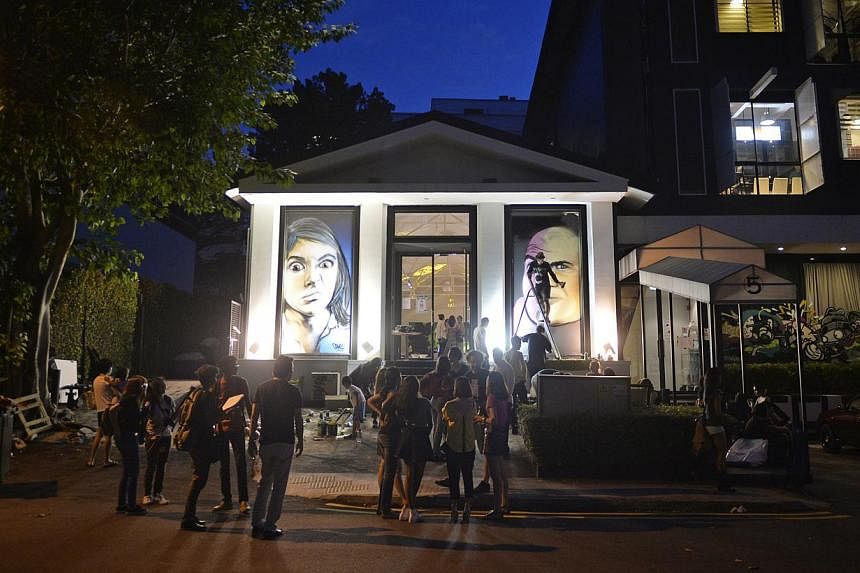SINGAPORE - Some art pieces on display at The Mill's Destruction & Rebirth art initiative to mark the design hub's redevelopment were vandalised on Jan 31.
Three artworks were severely damaged after a dance party on the premises along Bukit Merah Road on that Saturday night, including vandalised photographs from Panagiotis Kotsidas and Miro Roman's An Urban Diptych, as well as a brickwork installation by Lai Chee Kien titled Double Cauldron, which was broken but has since been restored.
Here are five other cases of art vandalism in public in Singapore and abroad:
1. January 2014
An art installation made with reproductions of $2, $5, $10 and $50 notes, named Prosperity Tunnel, was vandalised. It was commissioned by Jurong Point and created by Mr Casey Chen, 42. It was made using wallpaper and stickers printed with images of currency notes. The notes were not exact copies as each was about 30 per cent larger than an actual note and has the word "specimen" printed in red.

Someone removed a 30cm by 30cm portion from it. The installation however had to be taken down because it breached Monetary Authority of Singapore (MAS) guidelines. It was located along the underground walk link between Jurong Point and Boon Lay Bus Interchange. Approval from MAS must be sought and a permit is required for any reproduction of currency. Among other conditions, the reproduction's length and width must be enlarged to at least 150 per cent or reduced to 60 per cent or less of a genuine currency note.
2. August 2012

The works of Lithuania-born international artist Ernest Zacharevic were vandalised in Penang. Mr Zacharevic, who has shown his street art talent in Jalan Pisang and Jalan Klapa, in Singapore, is most well known for his art for the 2012 Georgetown Festival in Penang, Malaysia.
His murals in the heritage enclave were however first splattered with wax, then vandalised with black marks. A mural depicting a boy with his pet dinosaur, had black scribbles all over the boy's face. While those who saw the vandalism were appalled, Mr Zacharevic himself was quite a cool cucumber.
Speaking about the vandalism, he told The Straits Times in 2013: "I don't really care. If I cared about what happened to each painting, I would never get it done, or even started working outdoors in the streets in the first place."
3. November 2011

One of 162 baby elephant statues displayed as part of the Elephant Parade Singapore exhibition was vandalised, with a huge chunk of its paint ripped off.
The 1.5m tall life-size statues, were painted by artists and celebrities to help raise awareness of the endangered Asian elephants.
The damaged was sitting outside the Asian Civilisations Museum in Empress Place. Its "skin", painted to look like a durian, has had a chunk of green paint stripped off its left flank, exposing the brown base.
This statue was the work of Malaysian artist Hamir Soib, 42, who filed a complaint with the organisers. He eventually patched it up, but left the "scars" on the elephant. The elephants were auctioned off.
4. October 2005

More than a dozen paper rabbits and three origami Astroboys went missing from the mixed media installation artwork of Brian Gothong Tan at the Esplanade tunnel. Fellow artist Shirley Soh's work, The Soap Landscape, was also vandalised. Footprints and dents made by fingers and sharp objects damaged the five soap stools placed in the CityLink Mall tunnel leading to the Esplanade. Since the motive is public interaction, she was prepared for thefts and defacement. She did not however approve of the vandalism.
5. May 2000

An exhibit placed in the square outside Chinatown Complex was vandalised. The piece, entitled Dragon, comprised four mirrors and several epoxy fragments. It was installed on the night of May 7, 2000. When its creator, Ms Felicia Low, returned to the site the next afternoon, it was gone. After searching with the help of a few elderly men who often lingered around the area, she found her work in a rubbish dump one block away. What was puzzling about the incident was that the cheap epoxy parts of the piece, which together formed a dragon's body, were stolen, whereas the acrylic mirror panels, which were costlier, had been left behind, save for one. Another panel had been broken just so a large epoxy portion could be taken out. Epoxy is a synthetic resin used commonly in adhesives and surface coatings.
Source: The Straits Times

